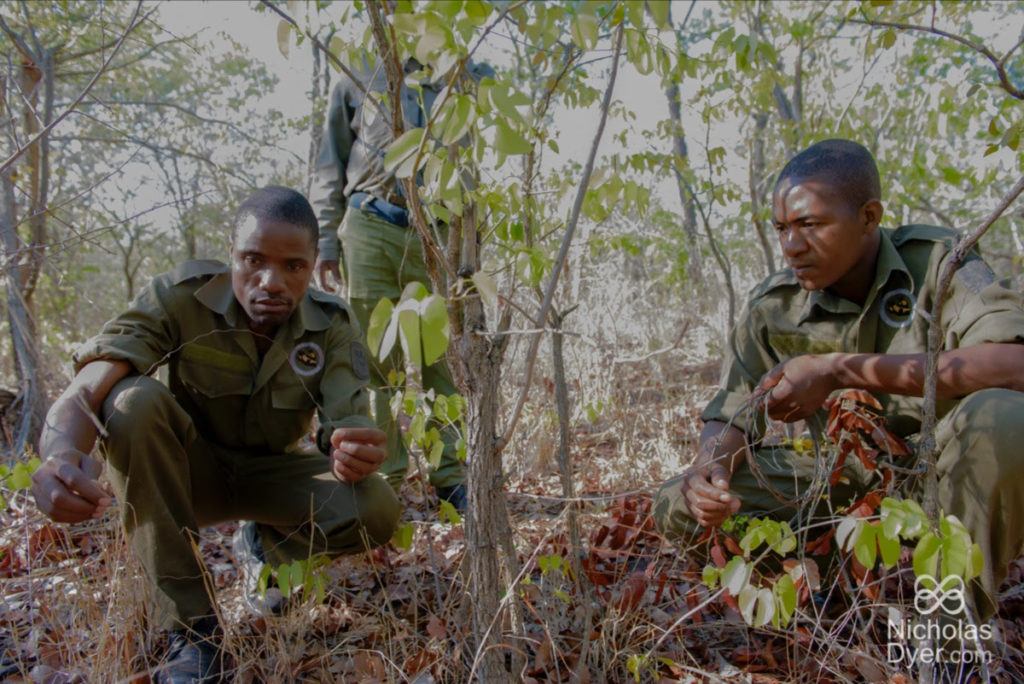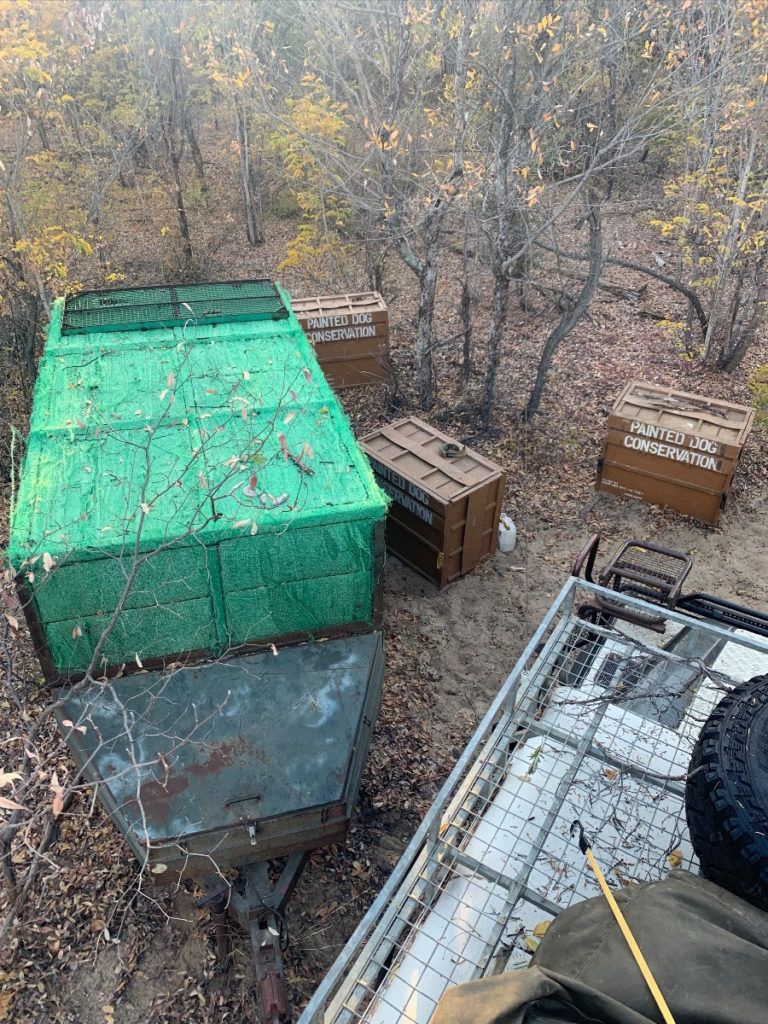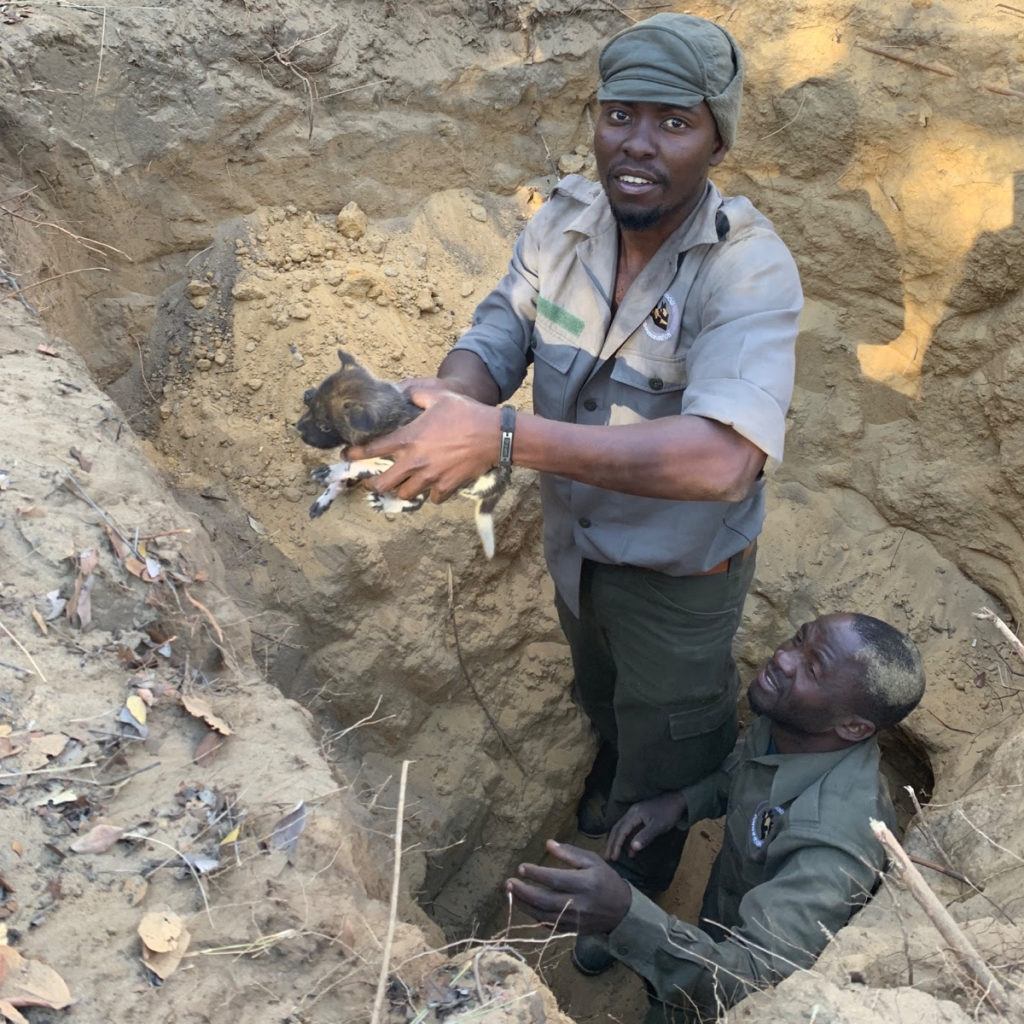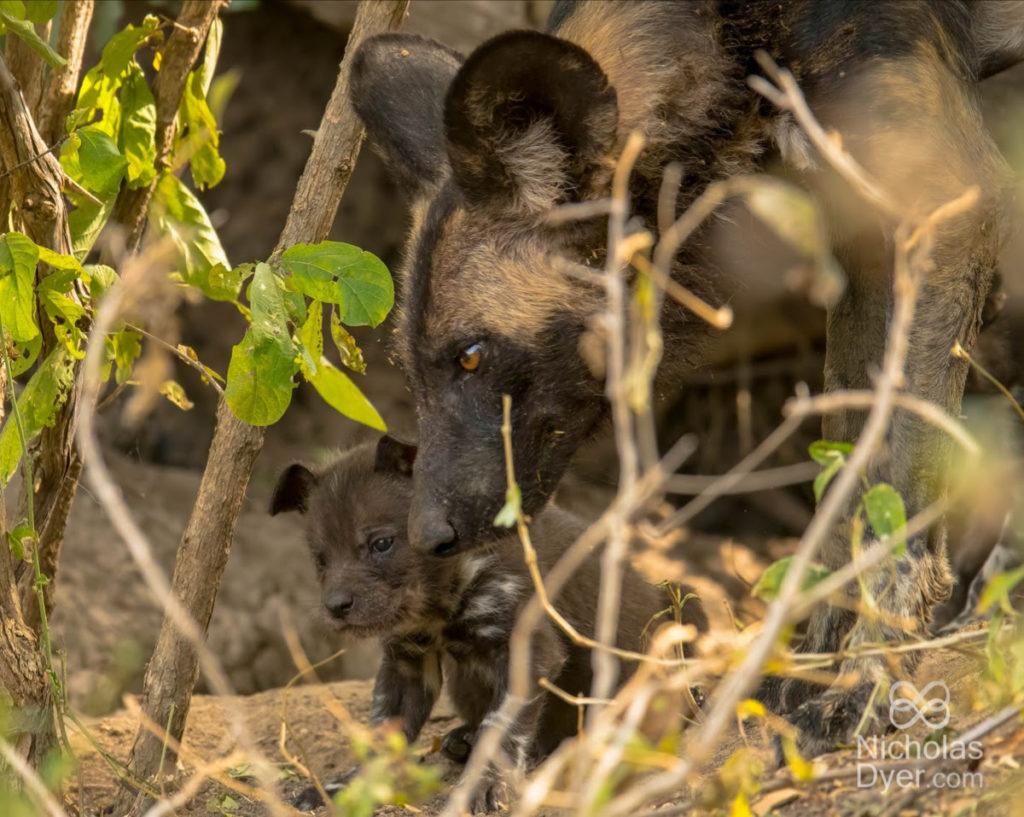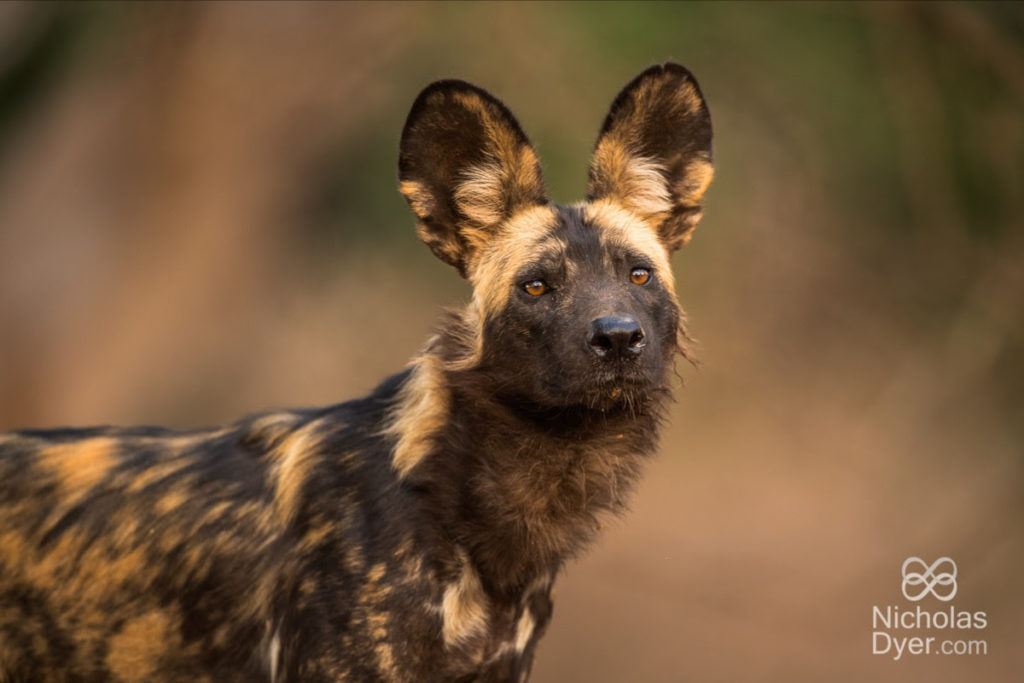
There are no certainties in conservation, and indeed life, however capturing the Mphindo pack for the second time was as guaranteed as anything can be in this life. Or so we thought!
Our team had been on the ground for more than a week when Jealous and I arrived with the equipment for the capture. The team, led by Enock Zulu, had been protecting the pack’s den, sweeping the area for snares and demonstrating to the community that we were taking action to resolve the situation once again.
We parked our Land Rovers approximately 1km from the den and walked in. Jealous checked for the signal from alpha female Snowtail’s collar, confirming she was at the den. However, alpha male Jonathan wasn’t there. My “certainty” began to feel less certain. We actually didn’t know how many adults were left in the pack, how many of last year’s pups were still alive, or even if Jonathan was alive at all. All we knew is that there was a den and Snowtail was there.
As we approached the den and her precious pups, Snowtail moved away, but remained ever vigilant, silently watching our every move. There was only one hole and so the team began the elaborate process of setting the safe snares we use in such situations, to catch the adults. It is the only method we can use to be sure we catch all the adults. Even if it takes all night. Very different to a typical collaring exercise where I just need to dart one dog.
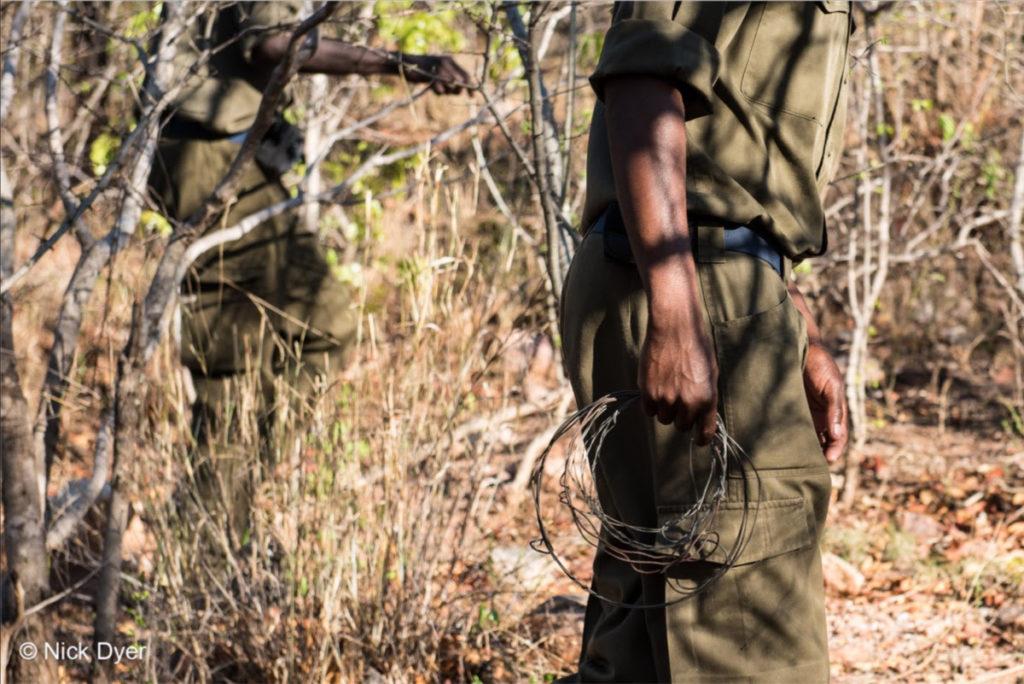
These safe snares are custom-made from high-grade aircraft cable. They have a stopper at the average neck size of an adult painted dog so will not strangle one. Once the snares are set, we wait quietly at a reasonable distance, so we can hear when a dog gets caught, then rush in and grab the dog by hand to administer the immobilizing injection. It’s quite an adrenalin rush, but all the time we are painfully aware of the stress it is causing the dogs and it is a system we use only as a last resort. We would never use it for something routine, like collaring a dog, though sadly I know of those who do use it in such circumstances.
I sat in my Land Rover drinking coffee as the team went about their work. Snowtail came around to check me out once or twice, seemingly more curious than agitated. Still there was no sign of Jonathan or any of last year’s pups. I knew we would capture Snowtail and collect her pups. I knew there were more adult dogs, at least two, but I now questioned if we could capture them as well. The certainty of success faded a little bit more.
After three hours, Jealous and the team emerged from the forests having set 37 of the safe snares. Jealous and I prepared ourselves for what we expected to be a long cold night. The rest of the team waited 500 meters away for our signal to assist once we had the dogs. As usual, Jealous and I would do the actual catching. We stood by my Land Rover, talking quietly as the temperature dropped as rapidly as the sun. We prepared our capture kit, consisting of a blanket and a pair of gloves, and talked about the “missing” dogs, who then suddenly appeared as if on cue!
I flicked to Jonathan’s collar frequency on my receiver and it beeped loudly. He must have come running in from afar. It didn’t matter. We could clearly see Snowtail, Jonathan, and one of last year’s pups (now nearly full-grown). Three dogs to catch. I had already prepared five syringes of immobilizing drugs.
Our wide smiles were soon wiped off our faces as we heard the familiar, distinctive sound of a painted dog caught in a snare. We grabbed our kit and ran in. Jonathan and last year’s pup were caught in the snares. Snowtail was still running around, now very agitated.
Without hesitation, Jealous grabbed Jonathan, who understandably tried to bite him. We quickly covered his head with the blanket and I administered the immobilizing injection. I took off my jacket and covered Jonathan’s head. Jealous took the blanket and ran to the pup and grabbed him. Snowtail was then caught in a snare. We had all three in less than 20 minutes. Certainty guaranteed!
The immobilizing drugs took effect and I released Jonathan from the snare and ran over to inject the pup Jealous was holding. He then ran over and grabbed Snowtail to stop her struggling while I held onto last year’s pup. The adrenaline pumped through our veins yet we were calm and focused. We knew what we were doing and the consequences of failure could be death for one or more of the dogs.
All three dogs were now immobilized and I ran to my Land Rover and called in the rest of the team. We carried the dogs out to the waiting transport crates, checked them for any physical damage, and placed them in the crates. Then, within minutes after administering the reversal drug they were wide awake again. We named last year’s pup Survivor. He was the only one left out of the ten born in June 2018.
As for the pups still in the den, we had to wait through the cold of the night before we could attempt to capture the pups. I hated this. I was worried about the pups and didn’t sleep. But as Jealous says “you don’t sleep anyway.”
At first light we began digging and digging. I have to say that this is a proverbial “we.” I’m not known for my digging skills, but I’m very good at pointing and giving instructions. The birth chamber of the pups is approximately two meters underground and reached via a five to seven-meter-long tunnel that extends down at a 45-degree angle. It’s a lot of digging.
After three hours we reached the seven tiny wiggling pups, carefully lifted them out of the den, and reunited them with Snowtail in the crate. Though five weeks old and already eating regurgitated meat, the pups still suckle and all seven pounced on their accommodating mum.
Three hours later we were all back at our world-class Rehabilitation Centre. It’s at times like this that I reflect on the relationships and support we receive from all corners of the world. John Lemon, for example, from Australia, who built our Rehab that safely houses the dogs, and the people who supported him, not least, his long-suffering wife, Angela! The individuals and organizations that believe in and support PDC make it possible for us to undertake such critical interventions, and to save the lives of not one but, in this case, ten painted dogs.
Ten painted dogs might not sound like many, and some would look at the cost and dismiss the entire operation as too expensive. But, as I’ve said many times before, saving the life of just one dog can have an impact on the species for years to come (witness the 137 descendants of Visule).
I continue to be eternally grateful that when it comes to saving the life of a dog, I don’t have to pause and weigh the costs of doing so. Because of your generous support, we are able to send rescue teams to the field whenever necessary or deploy our entire APU into an area to protect them.
Your support is immeasurable. Be it financial, (which of course is what we love most!) or emotional or simply endlessly encouraging, we love and cherish it all and cannot do what we do without you.
Read about PDC’s first rescue operation of the Mphindo pack.


